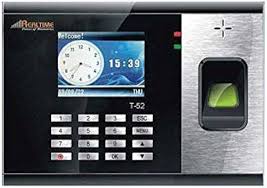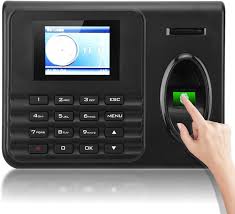In today’s fast-paced world, technology continues to revolutionize the way we work and interact with various systems. One such technological advancement that has gained significant popularity is the real-time biometric machine.
A real-time biometric machine utilizes cutting-edge biometric technology to accurately verify and authenticate individuals based on their unique biological traits such as fingerprints, facial features, iris patterns, or voice recognition. This advanced system offers a secure and efficient way of managing access control, time and attendance tracking, and identity verification processes.
One of the key benefits of a real-time biometric machine is its ability to provide instant verification results, allowing for quick and seamless access to secure areas or systems. This real-time functionality enhances security measures by ensuring that only authorized personnel are granted entry.
Moreover, real-time biometric machines offer a high level of accuracy and reliability compared to traditional identification methods such as passwords or ID cards. Biometric data is unique to each individual, making it extremely difficult for unauthorized users to bypass the system.
Organizations across various industries are increasingly adopting real-time biometric machines to streamline their operations, improve security protocols, and enhance overall efficiency. From corporate offices and government agencies to educational institutions and healthcare facilities, the versatility of these advanced systems makes them an invaluable asset in today’s digital age.
As technology continues to evolve, real-time biometric machines are expected to play a crucial role in shaping the future of security and authentication processes. With their speed, accuracy, and reliability, these innovative devices are set to revolutionize how organizations manage access control and identity verification in real-time scenarios.
Top 5 Advantages of Real-Time Biometric Machines
- Enhanced Security
- Efficient Access Control
- Reliable Identification
- Convenient Authentication
- Real-Time Verification
Challenges of Real-Time Biometric Systems: Privacy, Cost, Maintenance, and Compatibility
Enhanced Security
Real-time biometric machines provide enhanced security by leveraging unique biological traits to accurately verify individuals, significantly reducing the risk of unauthorized access. This advanced technology ensures that only authorized personnel are granted entry, making it a highly effective security measure for various applications. By relying on biometric data such as fingerprints, facial features, iris patterns, or voice recognition, real-time biometric machines offer a robust and reliable solution to safeguard sensitive areas and information from potential security breaches.
Efficient Access Control
Real-time biometric machines offer the pro of efficient access control by providing quick and seamless access to secure areas or systems. By utilizing cutting-edge biometric technology, these systems enhance operational efficiency and productivity within organizations. Employees and authorized personnel can gain access to restricted areas or systems swiftly, without the need for manual verification processes or keycards. This streamlined approach not only saves time but also ensures a higher level of security by accurately verifying individuals based on their unique biological traits. Overall, the efficient access control feature of real-time biometric machines significantly contributes to optimizing workflow processes and enhancing overall organizational productivity.
Reliable Identification
The reliability of real-time biometric machines lies in their ability to provide accurate identification through unique biometric data associated with each individual. This ensures a high level of security by significantly reducing the likelihood of identity fraud or theft. By leveraging the distinct biological traits of individuals such as fingerprints, facial features, iris patterns, or voice recognition, these advanced systems offer a robust authentication process that is difficult to replicate or manipulate. This pro highlights the effectiveness of real-time biometric machines in safeguarding sensitive information and securing access to restricted areas with unparalleled precision and trustworthiness.
Convenient Authentication
Convenient Authentication: Real-time biometric machines offer users a seamless and convenient way to verify their identity through unique biometric traits like fingerprints or facial recognition. By eliminating the need for cumbersome passwords or physical ID cards, this pro of biometric authentication not only enhances security but also streamlines the authentication process for users. With just a quick scan or glance, individuals can effortlessly gain access to secure areas or systems, making the authentication experience efficient and user-friendly.
Real-Time Verification
The real-time verification capability of biometric machines offers organizations the advantage of receiving instant verification results. This feature allows for swift decision-making in terms of access control and time-sensitive processes, ultimately bolstering overall security measures. By providing immediate feedback on the authenticity of an individual’s identity, real-time biometric machines empower organizations to efficiently manage access to secure areas and time-sensitive operations, ensuring that only authorized personnel are granted entry. This quick and reliable verification process contributes significantly to enhancing security protocols and streamlining operational efficiency in various industries.
Privacy concerns
One significant con of real-time biometric machines is the privacy concerns they raise. These advanced systems collect and store sensitive biometric data, such as fingerprints, facial features, iris patterns, or voice recognition, which can be a cause for worry regarding the security and potential misuse of this information. The storage of such personal and unique data poses a risk of unauthorized access or hacking, potentially leading to identity theft or other privacy breaches. As organizations increasingly rely on real-time biometric machines for authentication and access control, addressing these privacy concerns and implementing robust security measures to safeguard biometric data becomes paramount to ensure user trust and data protection.
Costly implementation
One significant drawback of real-time biometric machines is the costly implementation involved. The initial setup and integration of these advanced systems can be expensive, posing a financial challenge for organizations operating with limited budgets. The high costs associated with acquiring the necessary hardware, software, and infrastructure for deploying real-time biometric machines can deter some businesses from adopting this technology despite its numerous benefits. As a result, cost considerations remain a key factor that organizations must weigh when evaluating the feasibility of implementing real-time biometric solutions.
Maintenance challenges
One significant drawback of real-time biometric machines is the maintenance challenges they pose. These advanced systems demand regular maintenance and software updates to uphold their optimal performance levels, which can be both time-consuming and costly for organizations. Ensuring that the biometric machine functions effectively and accurately requires dedicated attention from IT personnel or external service providers, adding an additional layer of complexity to the overall management of the system. The need for ongoing maintenance can disrupt daily operations and result in downtime if not managed efficiently, potentially impacting productivity and security measures within the organization.
Compatibility issues
One significant drawback of real-time biometric machines is the potential compatibility issues they may encounter with existing hardware or software infrastructure. These compatibility issues can pose integration challenges for organizations looking to implement biometric systems seamlessly into their operations. Incompatibility between the biometric machine and other systems within the organization can result in delays, technical glitches, and additional costs associated with resolving integration issues. As a result, organizations must carefully assess the compatibility of real-time biometric systems with their current technology environment to ensure a smooth and successful implementation process.



